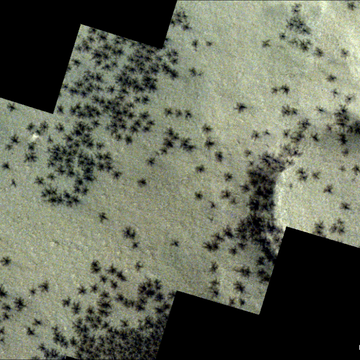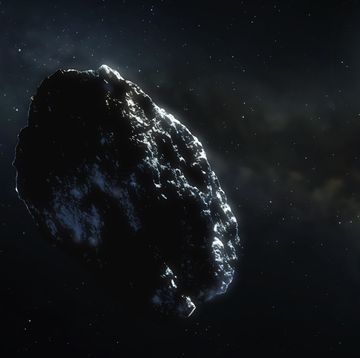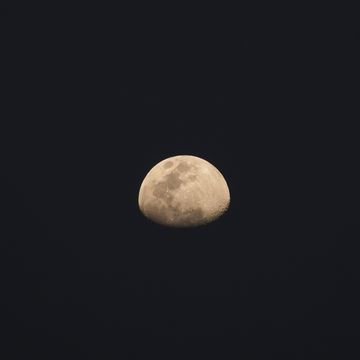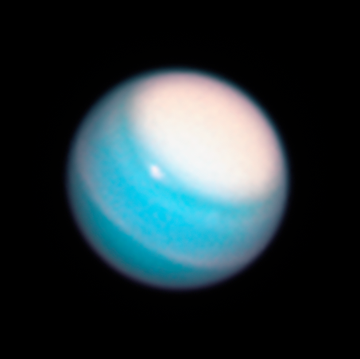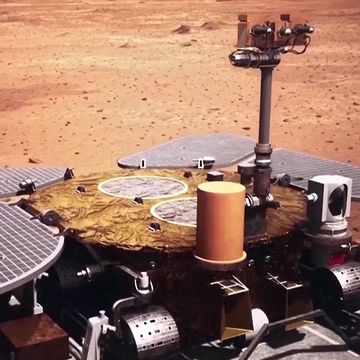- A Twitter video of the moon, supposedly taken at the North Pole, shows a gigantic version of our neighbor.
- While stunning, it's a fake video that some people nevertheless assumed is real.
- We debunk the video with cool facts about what would happen if the moon were really that big.
On a full-moon night, you may look up at our glowing nocturnal neighbor and feel a sense of peace and wonder. Even a video of the moon can be beautiful.
Those feelings turned to confusion for many people on Tuesday, April 26, when they viewed a Twitter video of an alarmingly close and massive moon when viewed from the North Pole. As described on The Big Lead, the moon looks like “the damn Death Star coming out of hyperspace.”
During the 30-second clip, the moon appears to balloon dramatically in the sky, even swallowing up the sun for about five seconds.
👀 Discover the truth about your world and get unlimited access to Pop Mech, starting now.
The viral video is fake, made with CGI, but since @BeachDog15 posted it on April 26, it has more than 301,000 likes and 67.9 thousand retweets at the time of publication. According to the comments, some people still think it’s real.
NASA notes that, on average, the moon is 238,855 miles miles away from Earth, which is about 30 Earths away. Our only natural satellite, the moon’s average diameter is 2,158 miles (it varies from poles to equator since it’s not a perfect sphere.)
If it really looked as big as the video indicates, it would either be 20 times bigger at the same distance, or be the same size but 20 times closer. That would put it only about 12,600 miles from Earth, and the effect on Earth would be terrible, astronomer Bing F. Quock told Popular Mechanics in an email. As the assistant director of the Morrison Planetarium at the California Academy of Sciences in San Francisco, he quickly found several things wrong with the video when he compared the sizes of the moon and the sun on his computer screen. Quock figured that the Moon appears much wider than the sun from Earth’s perspective. If that video reflected reality, he says in an email, it would paint one of two cataclysmic pictures.
Either the moon’s distance from us would be only about one-twentieth its actual distance (meaning it would be only about 12,600 miles away from Earth), or its diameter would be about 44,450 miles, about 20 times wider than the moon really is, Quock says.
“If the former were the case, gravitational force would be 400 times greater (inversely proportional to distance), causing catastrophic flooding at high tide, compared to what we're presently used to. There might also be effects on Earth’s tectonic plates, causing increased volcanic and seismic activity,” says Quock.
And in the latter case, if the moon were 20 times bigger, it would be five times the diameter of Earth. In that case, it could be called a super-Earth, Quock says. "Exactly how massive it would be depends on its composition, and I believe there's a limit to how big a rocky body can get before liquifying. The gravitational dynamic would be reversed, and Earth would be its satellite," he explains. In this case, Earth would be tidally locked, as all moons in the solar system are around their planets, he adds. That means only one side of Earth would always face the Moon. What kind of place would Earth be then? It's hard to say.
In the video, the moon also appears to be spinning, which is just wrong, since its orbit is tidally locked. And as one astrophysicist commenter, @Astropartigirl, pointed out in her own video response, “This is the North Pole, right? So where’s all the ice?”
Normally, the moon’s gravity governs predictable sea tides, literally pulling water up from the Earth’s surface. The phenomenon we call high tide occurs on opposite sides of Earth: it is high tide on the side closest to the moon, and also on the side farthest from the moon. This latter high tide is due to inertia, as Earth itself is pulled slightly toward the moon. Low tides are between these two swellings of water. Even smaller bodies of water like lakes, and indeed Earth’s entire crust, feels the pull of the moon. Our smaller neighbor also affects Earth’s rate of rotation, slowing it infinitesimally. Every century, our days get 2.3 milliseconds longer.
Even our climate is thanks in part to the moon. Without its gravitational influence, Earth’s tilted position wouldn’t have a stable, tiny degree of wobble, which has supported a suitable climate for life as we know it.
If it were real, then the moon portrayed in the Twitter video would be a much harsher companion.
With more than 5.5 thousand comments by Thursday morning, this video has gotten a lot of traction. Some of the commenters have a sense of humor, like the user @afootballfeast, who writes, “People saying this is fake are just not well travelled. I’ve been there. Well not that exact spot, I was actually closer to the horizon, just on the spot where you can briefly touch the moon as it passes.”
Another commenter laments that their dog got too excited, jumped, and the moon pulled the pet away, into its gravitational field. Apparently, he’s still there.
Before joining Popular Mechanics, Manasee Wagh worked as a newspaper reporter, a science journalist, a tech writer, and a computer engineer. She’s always looking for ways to combine the three greatest joys in her life: science, travel, and food.


